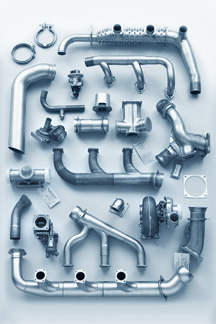Inspection of exhaust parts is crucial. A small exhaust discrepancy can result in carbon monoxide poisoning, loss of power, or fire, so it is imperative that these inspections are very thorough.
Here are some inspection tips:
- Look for leaks. They usually show up as chalky, dusty gray deposits inside the cowling and on surfaces adjacent to the exhaust parts. Stains can also be white, black, red or even yellow. You can also hook up a vacuum cleaner's exhaust to the tailpipe and apply soapy water or talcum powder.
- Check the connections. Clamps and gaskets should seal, and slip joints should slip. There is usually some leakage here; you are looking for excessive amounts. It is not unusual for the male component of a slip joint to "mushroom" out to the point where the parts are seized. Be sure to follow the manufacturers' recommendations for continuing maintenance on these items.
- Look for pitting and corrosion. Pitting is common in the bends, and corrosion is caused by moisture collecting in the low spots. The result can be pinholes or excessive thinning.
- Look for metal fatigue. This appears as a bulge or blister. Exhaust parts with any heat distortion would be replaced.
- Look at the baffles. Most mufflers have internal baffling of some kind- perforated tubes, cones, or sometimes simply steel plates. They should be intact with no distortion. Distorted or missing baffles cause hot spots on the muffler can, and broken baffles can obstruct the tailpipe. NOTE: Not all mufflers have baffles, so before you reject one, be sure it had baffles originally. It is a good idea to use a borescope to check their internal condition.
- Check for Manufacturer Service Bulletins and Airworthiness Directives (AD Notes). Those of us who do this for a living are continually amazed at how far exhaust systems are allowed to deteriorate before they are pulled. It is really scary to see some of the failed parts that were in service just yesterday. The best article I have seen on this subject was published by the Cessna Pilots Associatio, - volume 15, No. 4 - April 1998; it should be required reading for maintenance pros.
P.S. Don't use a lead pencil to mark on exhaust parts; it really does cause cracks.
|
|


|
|



